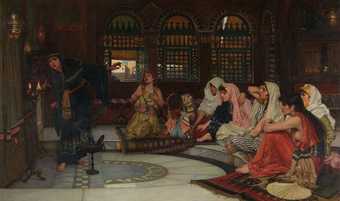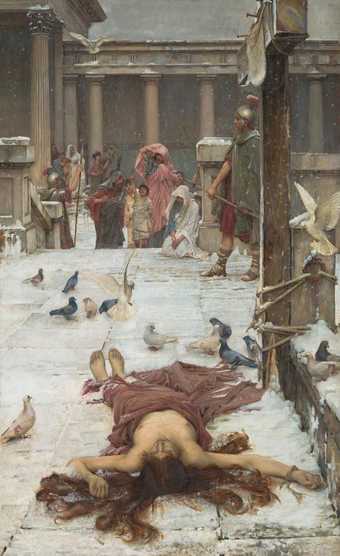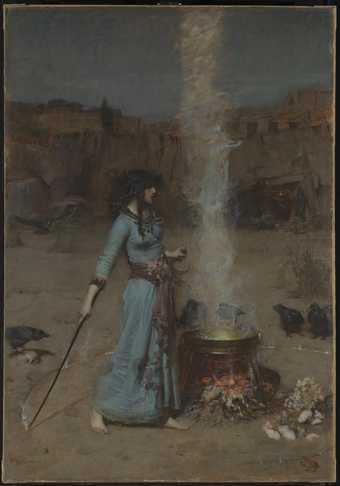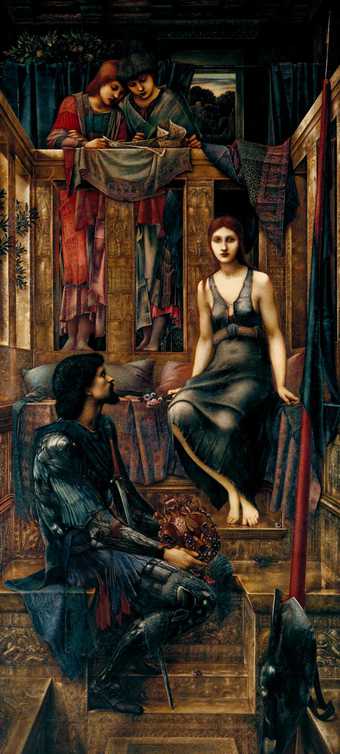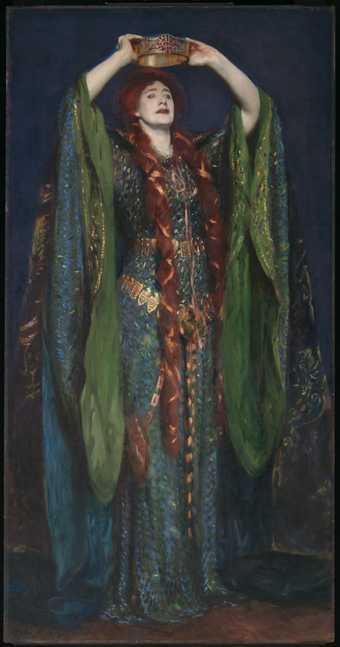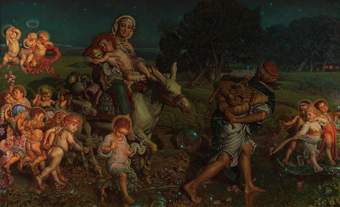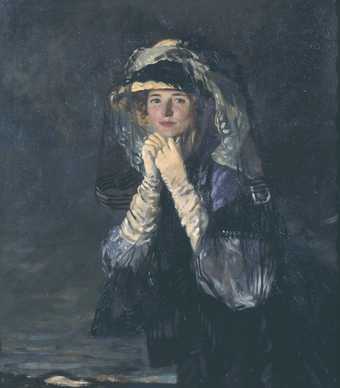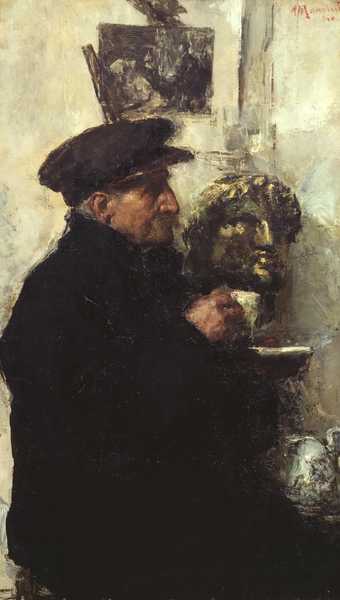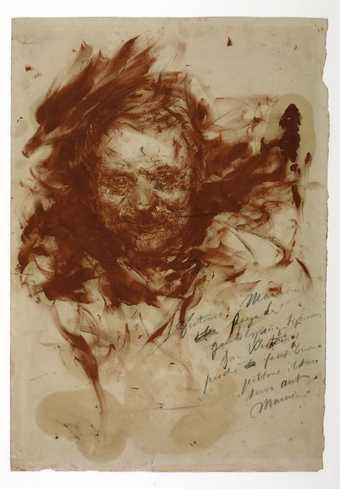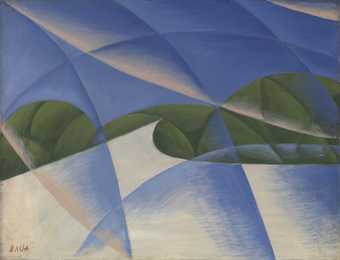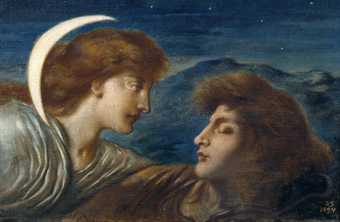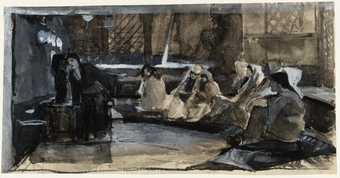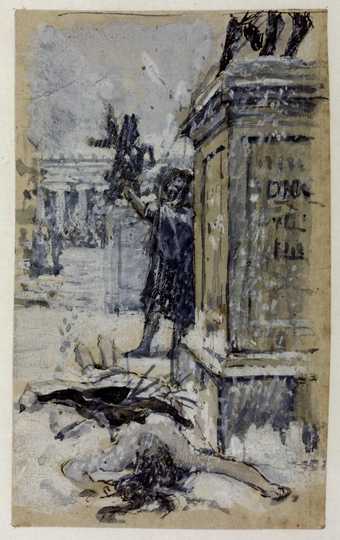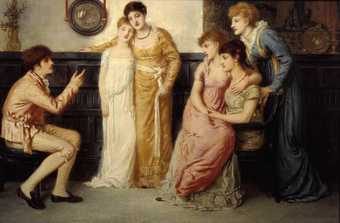
Not on display
- Artist
- John William Waterhouse 1849–1917
- Medium
- Oil paint on canvas
- Dimensions
- Support: 1530 × 2000 mm
frame: 2000 × 2460 × 230 mm - Collection
- Tate
- Acquisition
- Presented by Sir Henry Tate 1894
- Reference
- N01543
Summary
The picture illustrates the following lines from part IV of Tennyson’s ‘The Lady of Shalott’:
And down the river’s dim expanse
Like some bold seer in a trance,
Seeing all his own mischance –
With glassy countenance
Did she look to Camelot.
And at the closing of the day
She loosed the chain, and down she lay;
The broad stream bore her far away,
The Lady of Shalott.
Tennyson’s poem, first published in 1832, tells of a woman who suffers under an undisclosed curse. She lives isolated in a tower on an island called Shalott, on a river which flows down from King Arthur’s castle at Camelot. Not daring to look upon reality, she is allowed to see the outside world only through its reflection in a mirror. One day she glimpses the reflected image of the handsome knight Lancelot, and cannot resist looking at him directly. The mirror cracks from side to side, and she feels the curse come upon her. The punishment that follows results in her drifting in her boat downstream to Camelot ‘singing her last song’, but dying before she reaches there. Waterhouse shows her letting go the boat’s chain, while staring at a crucifix placed in front of three guttering candles. Tennyson was a popular subject for artists of this period, particularly the Pre-Raphaelites. Waterhouse’s biographer Anthony Hobson relates that the artist owned a copy of Tennyson’s collected works, and covered every blank page with pencil sketches for paintings.
The landscape setting is highly naturalistic; the painting was made during Waterhouse’s brief period of plein-air painting. The setting is not identified, although the Waterhouses frequently visited Somerset and Devon. The model is traditionally said to be the artist’s wife. Waterhouse’s sketchbook contains numerous pencil studies for this and the painting of the same title made six years later (1894, Leeds City Art Gallery). This second work shows the Lady at the moment she looks out of the window and the curse is fulfilled. Waterhouse also made sketches of the final scenes in which the boat bearing the Lady floats into Camelot.
The Lady of Shalott is one of the original paintings from the gift of Sir Henry Tate.
Further reading
Anthony Hobson, The Art and Life of J W Waterhouse RA 1849–1917, London 1980, pp.51–6, 183, reproduced pp.54–5 in colour.
Anthony Hobson, J W Waterhouse, Oxford 1989, pp.40–1, 53, 77, 109, reproduced p.42 in colour.
Terry Riggs
February 1998
Does this text contain inaccurate information or language that you feel we should improve or change? We would like to hear from you.
Display caption
English poet Alfred Tennyson’s poem The Lady of Shalott (1833) describes a heroine confined to a tower and cursed to die if she looks directly upon the outside world. By using a mirror, she embroiders scenes of passers-by. When the Lady glimpses the Arthurian knight Sir Lancelot she falls in love and defies the curse. Out in the cold world, on the point of death, she frees a boat to seek him. Lancelot is visible on her embroidery, and familiar Pre-Raphaelite clues foretell her fate: swallows fly low as the wind blows her hair and extinguishes the candles.
Gallery label, March 2022
Does this text contain inaccurate information or language that you feel we should improve or change? We would like to hear from you.
Film and audio
Features
Explore
- architecture(30,960)
-
- features(8,872)
-
- stair / step(514)
- emotions and human qualities(5,345)
-
- love(516)
- clothing and personal items(5,879)
- embroidery(12)
- crucifix(42)
- chain(54)
- actions: postures and motions(9,111)
-
- sitting(3,347)
- woman(9,110)
- birth to death(1,472)
-
- death(685)
- imprisonment(25)
- boat - non-specific(2,203)
You might like
-
John William Waterhouse Consulting the Oracle
1884 -
John William Waterhouse Saint Eulalia
exhibited 1885 -
John William Waterhouse The Magic Circle
1886 -
Marcus Stone Il y en a toujours un autre
1882 -
Sir Edward Coley Burne-Jones, Bt King Cophetua and the Beggar Maid
1884 -
John Singer Sargent Ellen Terry as Lady Macbeth
1889 -
William Holman Hunt The Triumph of the Innocents
1883–4 -
Sir William Orpen Lady Orpen
exhibited 1907 -
Antonio Mancini Portrait of the Artist’s Father
c.1903–4 -
Antonio Mancini Self-Portrait
c.1906 -
Giacomo Balla Abstract Speed - The Car has Passed
1913 -
Simeon Solomon The Moon and Sleep
1894 -
John William Waterhouse Study for ‘Consulting the Oracle’ Verso: Studies of (i) Same Composition (ii) Priestess on a Tripod Throne
c.1884 -
John William Waterhouse Study for ‘Saint Eulalia’
c.1885 -
Simeon Solomon A Youth Relating Tales to Ladies
1870

